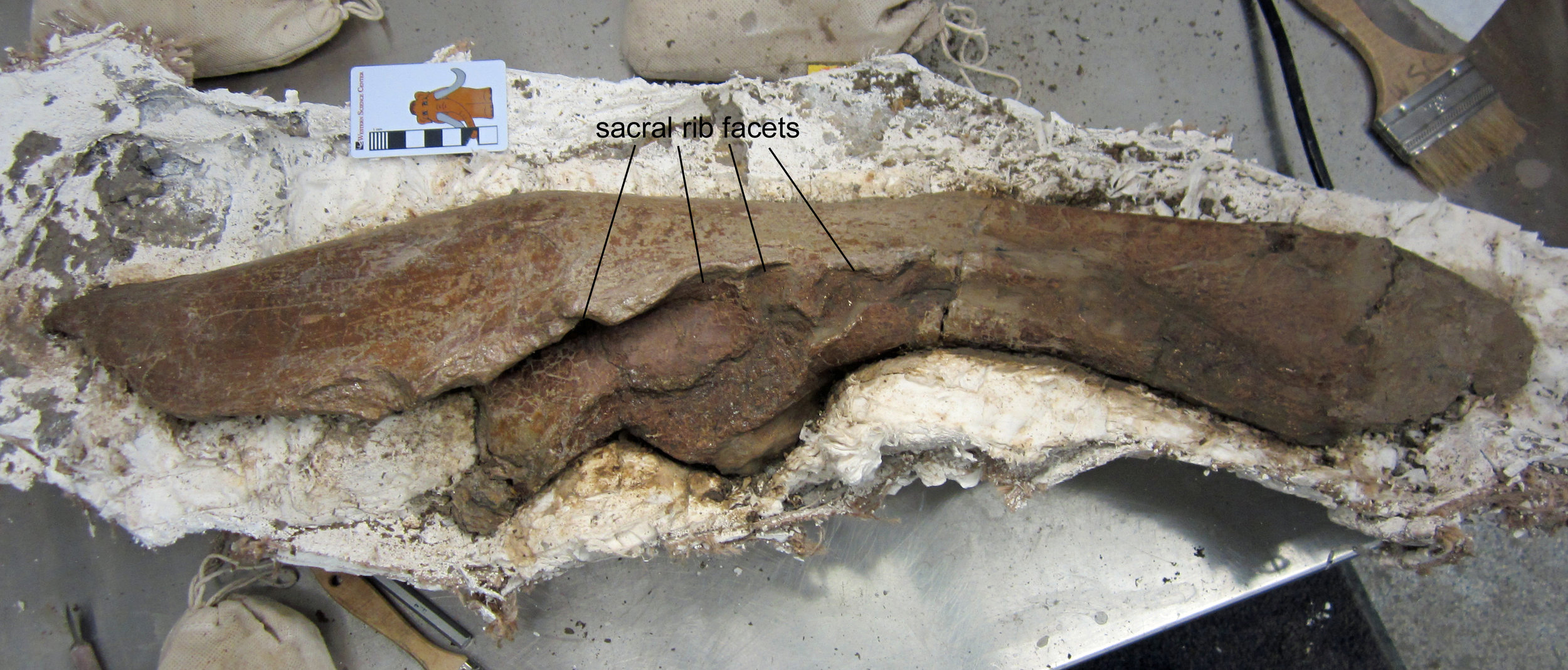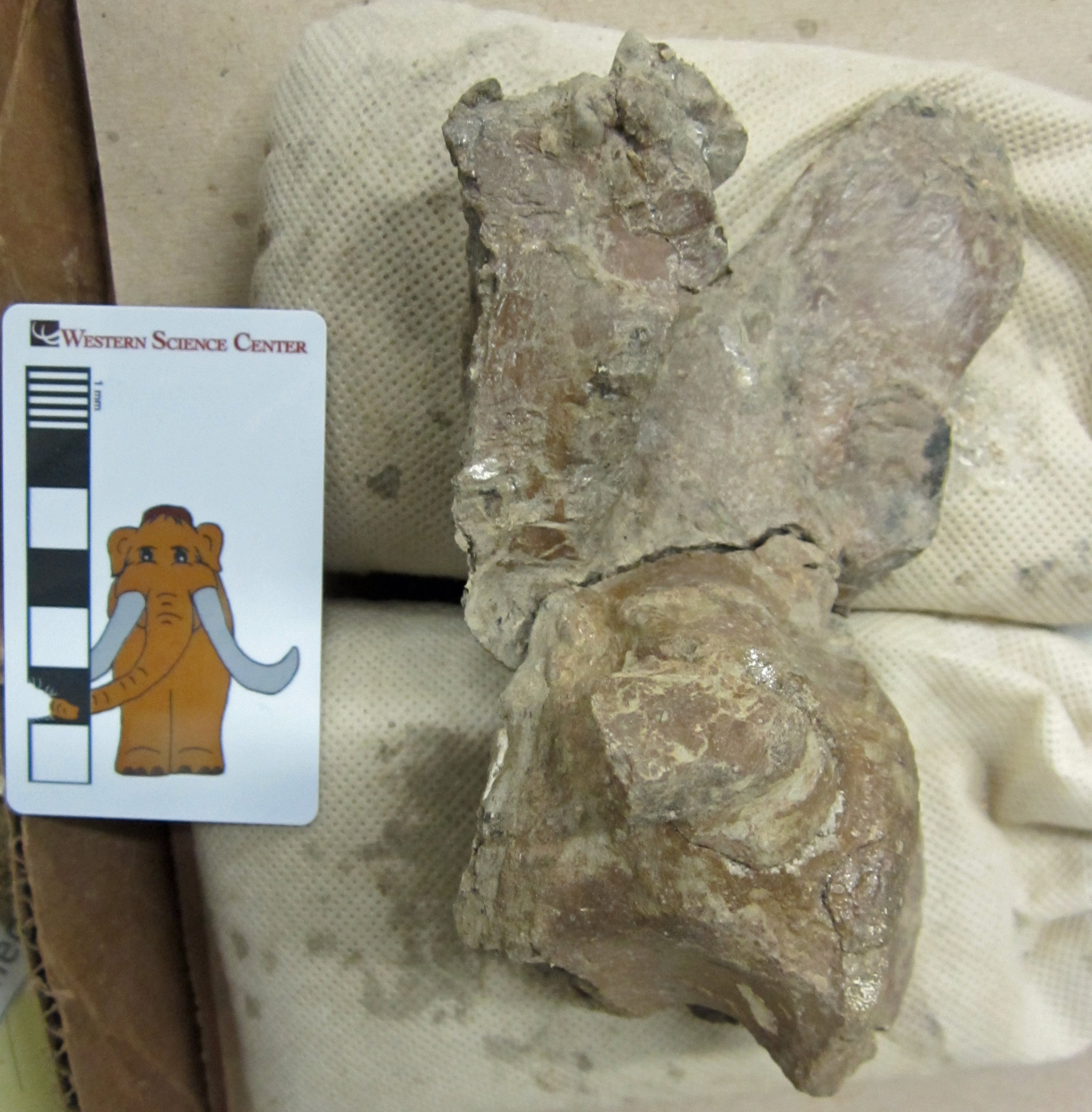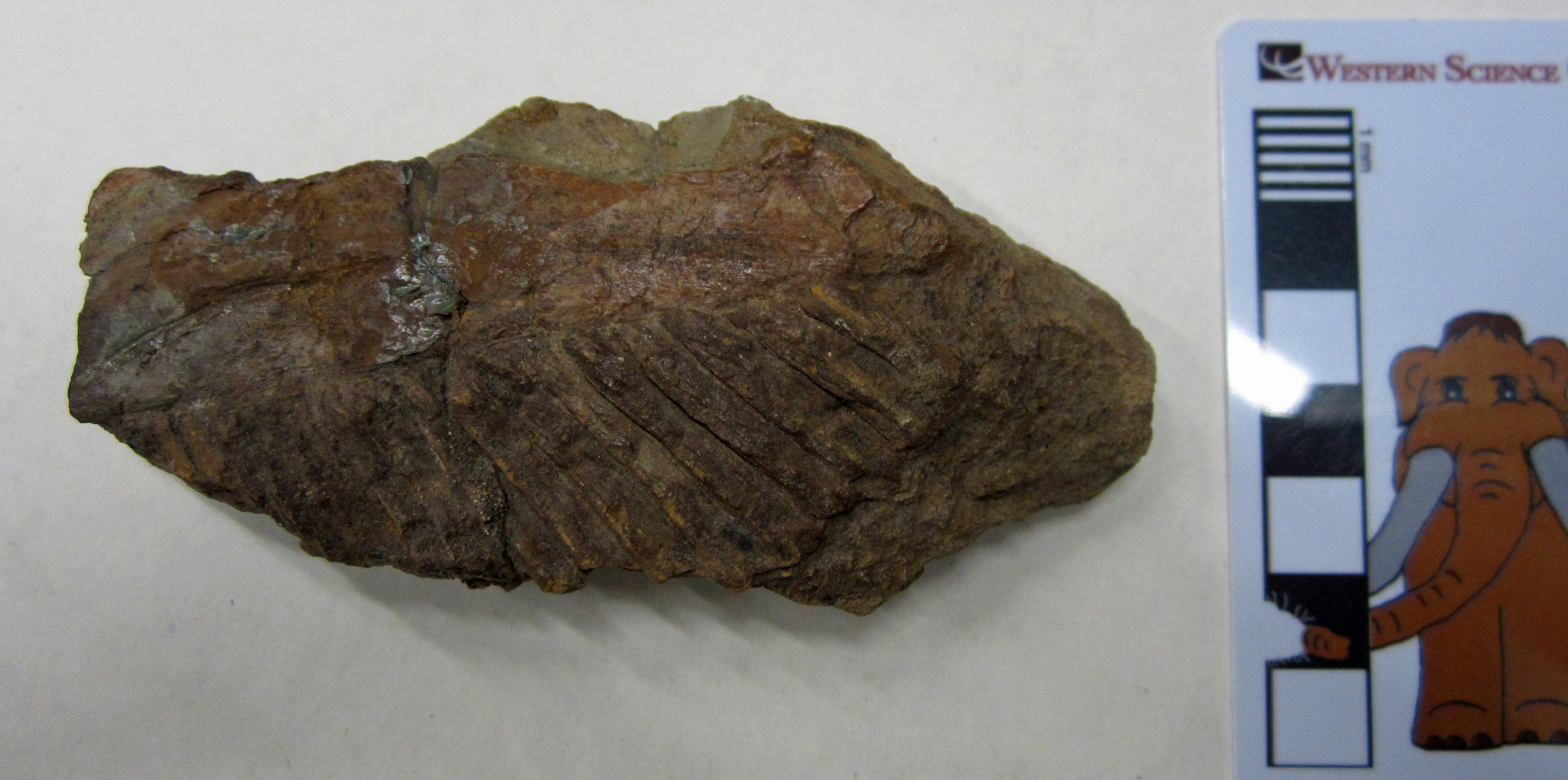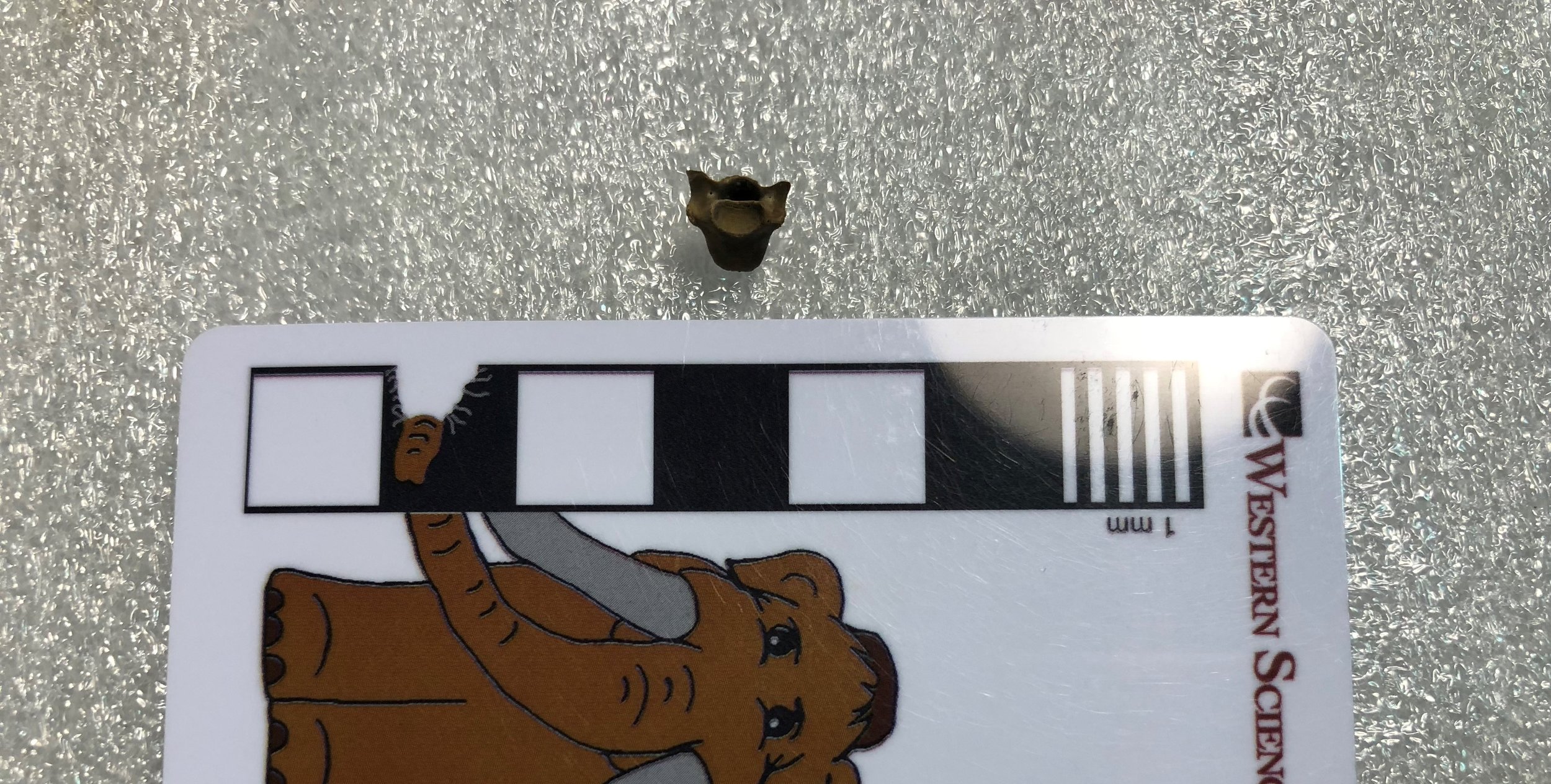 Last week for Fossil Friday, I posted the sacrum of a ceratopsid, a large horned dinosaur related to Triceratops. The sacrum is a series of fused vertebrae to which the hip bones attach. Today, I want to show you one of those hip bones from the same ceratopsid individual. This is the left ilium, showing the inner surface where it would have attached to the sacral ribs along a series of deep facets. At about 80 centimeters long, this ilium is not terribly big for a ceratopsid, but it still would have been a hefty animal, plodding around the forests and swamps of Late Cretaceous New Mexico.In the coming months, we will create 3D-printed replicas of the sacrum and ilium of this ceratopsid to see how they fit together, the first step in rebuilding this 79-million-year-old skeleton. We also have several vertebrae and ribs from the back. This specimen was collected during the 2017 and 2018 field seasons by staff and volunteers from the Western Science Center, Zuni Dinosaur Institute for Geosciences, and Southwest Paleontological Society. The sacrum and ilium have both been prepped by WSC lab volunteer Joe Reavis.Post by Curator Dr. Andrew McDonald.
Last week for Fossil Friday, I posted the sacrum of a ceratopsid, a large horned dinosaur related to Triceratops. The sacrum is a series of fused vertebrae to which the hip bones attach. Today, I want to show you one of those hip bones from the same ceratopsid individual. This is the left ilium, showing the inner surface where it would have attached to the sacral ribs along a series of deep facets. At about 80 centimeters long, this ilium is not terribly big for a ceratopsid, but it still would have been a hefty animal, plodding around the forests and swamps of Late Cretaceous New Mexico.In the coming months, we will create 3D-printed replicas of the sacrum and ilium of this ceratopsid to see how they fit together, the first step in rebuilding this 79-million-year-old skeleton. We also have several vertebrae and ribs from the back. This specimen was collected during the 2017 and 2018 field seasons by staff and volunteers from the Western Science Center, Zuni Dinosaur Institute for Geosciences, and Southwest Paleontological Society. The sacrum and ilium have both been prepped by WSC lab volunteer Joe Reavis.Post by Curator Dr. Andrew McDonald.
Fossil Friday - ceratopsian vertebra
 On January 25, I showed you a horned dinosaur vertebra that was still partially encased in its plaster field jacket. Western Science Center volunteer John Deleon has been working hard on this vertebra for the last several weeks and has made great progress. The vertebra is now completely freed from its jacket, and is awaiting a bit more matrix removal and gluing before it is finished.This vertebra is part of a partial ceratopsian skeleton excavated in New Mexico in 2018 by the Western Science Center, Zuni Dinosaur Institute for Geosciences, and Southwest Paleontological Society. At between 80 and 79 million years old, this skeleton is among the oldest specimens of large horned dinosaurs from North America. We are not yet certain what kind of horned dinosaur this is, but there are numerous more bones from the same animal waiting to be prepared in the WSC lab.Post by Curator Dr. Andrew McDonald.
On January 25, I showed you a horned dinosaur vertebra that was still partially encased in its plaster field jacket. Western Science Center volunteer John Deleon has been working hard on this vertebra for the last several weeks and has made great progress. The vertebra is now completely freed from its jacket, and is awaiting a bit more matrix removal and gluing before it is finished.This vertebra is part of a partial ceratopsian skeleton excavated in New Mexico in 2018 by the Western Science Center, Zuni Dinosaur Institute for Geosciences, and Southwest Paleontological Society. At between 80 and 79 million years old, this skeleton is among the oldest specimens of large horned dinosaurs from North America. We are not yet certain what kind of horned dinosaur this is, but there are numerous more bones from the same animal waiting to be prepared in the WSC lab.Post by Curator Dr. Andrew McDonald.
Fossil Friday - Palm Leaf
 The fossilized bones of dinosaurs and other prehistoric animals certainly hog the spotlight, and they are spectacular. But alongside the bones of giants such as Tyrannosaurus is a very different, much more abundant type of fossil: ancient plants. Paleobotany, the study of fossil plants, is a vital part of understanding Earth history. Fossil plants provide data on bygone environments, ecology, and climate.This fossil is the impression of a 67-million-year-old palm leaf. It was found in the Hell Creek Formation of Montana by local fossil hunter Harley Garbani and donated to the Western Science Center by his wife, Mary. The living plant probably looked much like modern palm trees, and points to a much warmer climate in Montana during the Late Cretaceous Epoch than today. Next time you see a living palm tree swaying in the breeze, imagine a T. rex under it seeking shade from the midday sun. Post by Curator Dr. Andrew McDonald
The fossilized bones of dinosaurs and other prehistoric animals certainly hog the spotlight, and they are spectacular. But alongside the bones of giants such as Tyrannosaurus is a very different, much more abundant type of fossil: ancient plants. Paleobotany, the study of fossil plants, is a vital part of understanding Earth history. Fossil plants provide data on bygone environments, ecology, and climate.This fossil is the impression of a 67-million-year-old palm leaf. It was found in the Hell Creek Formation of Montana by local fossil hunter Harley Garbani and donated to the Western Science Center by his wife, Mary. The living plant probably looked much like modern palm trees, and points to a much warmer climate in Montana during the Late Cretaceous Epoch than today. Next time you see a living palm tree swaying in the breeze, imagine a T. rex under it seeking shade from the midday sun. Post by Curator Dr. Andrew McDonald
Fossil Friday - Snake Vertebra
 In the opinion of this naturalist, snakes are among the most elegant animals ever to have evolved. The fossil record of extinct snakes was poorly known for a long time. However, recent discoveries have revealed that a diverse array of early snakes lived alongside the dinosaurs, as far back in time as the Middle Jurassic Epoch, over 165 million years ago. The earliest known snake is Eophis underwoodi, from the Middle Jurassic of England: http://www.nature.com/articles/ncomms6996Today's Fossil Friday subject is a fossil snake in the Western Science Center's collection. This is a vertebra of Coniophis precedens, a snake that lived during the Late Cretaceous Epoch, about 67 million years ago, alongside much bigger reptiles such as Tyrannosaurus and Triceratops. This specimen was collected by the late Harley Garbani in the Hell Creek Formation of Montana, and donated to the museum by his wife, Mary.
In the opinion of this naturalist, snakes are among the most elegant animals ever to have evolved. The fossil record of extinct snakes was poorly known for a long time. However, recent discoveries have revealed that a diverse array of early snakes lived alongside the dinosaurs, as far back in time as the Middle Jurassic Epoch, over 165 million years ago. The earliest known snake is Eophis underwoodi, from the Middle Jurassic of England: http://www.nature.com/articles/ncomms6996Today's Fossil Friday subject is a fossil snake in the Western Science Center's collection. This is a vertebra of Coniophis precedens, a snake that lived during the Late Cretaceous Epoch, about 67 million years ago, alongside much bigger reptiles such as Tyrannosaurus and Triceratops. This specimen was collected by the late Harley Garbani in the Hell Creek Formation of Montana, and donated to the museum by his wife, Mary.
These early snakes were not venomous, but instead killed their prey by constriction like living pythons and boas. Another Late Cretaceous snake, Sanajeh indicus from India, seems to have habitually preyed upon hatchling long-necked sauropod dinosaurs. Three skeletons of this snake have been discovered associated with fossils of sauropod nests, eggs, and hatchlings: http://journals.plos.org/plosbiology/article?id=10.1371/journal.pbio.1000322
Post by Curator Dr. Andrew McDonald

